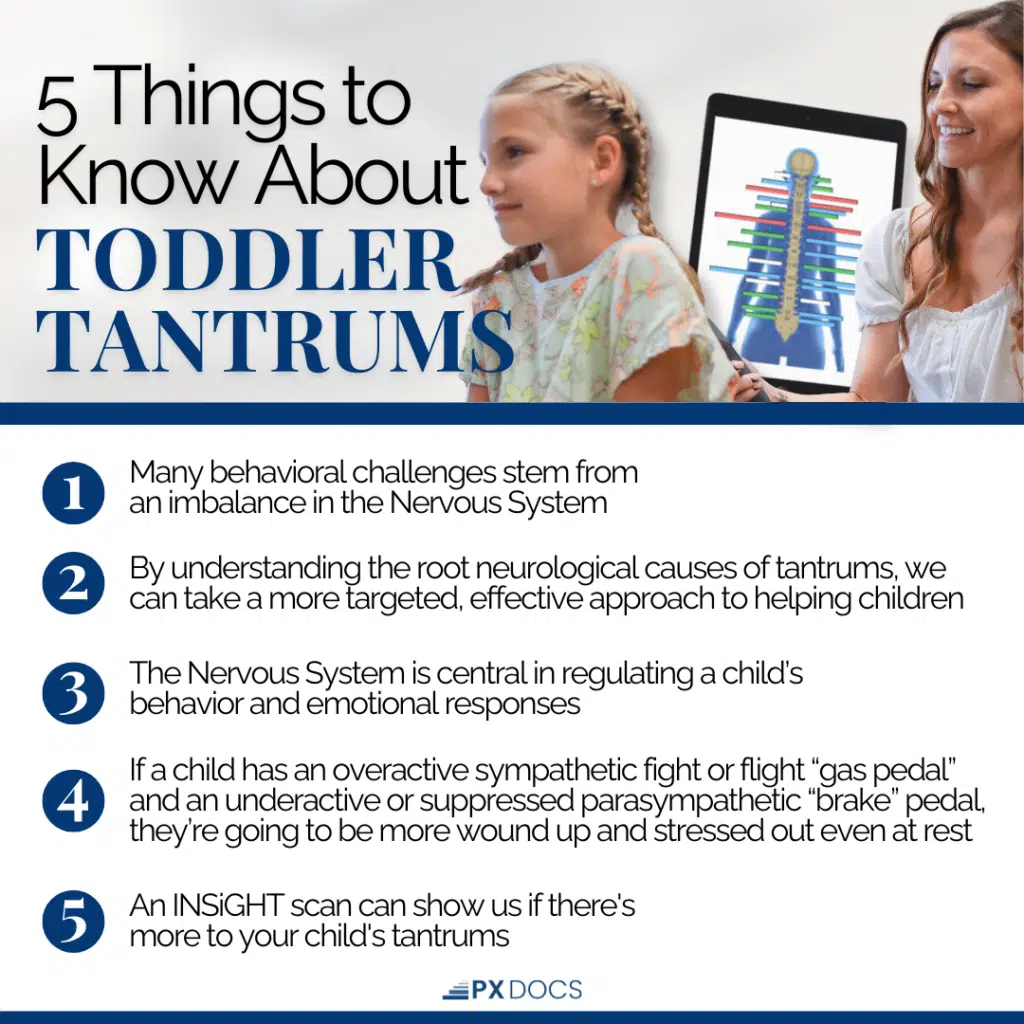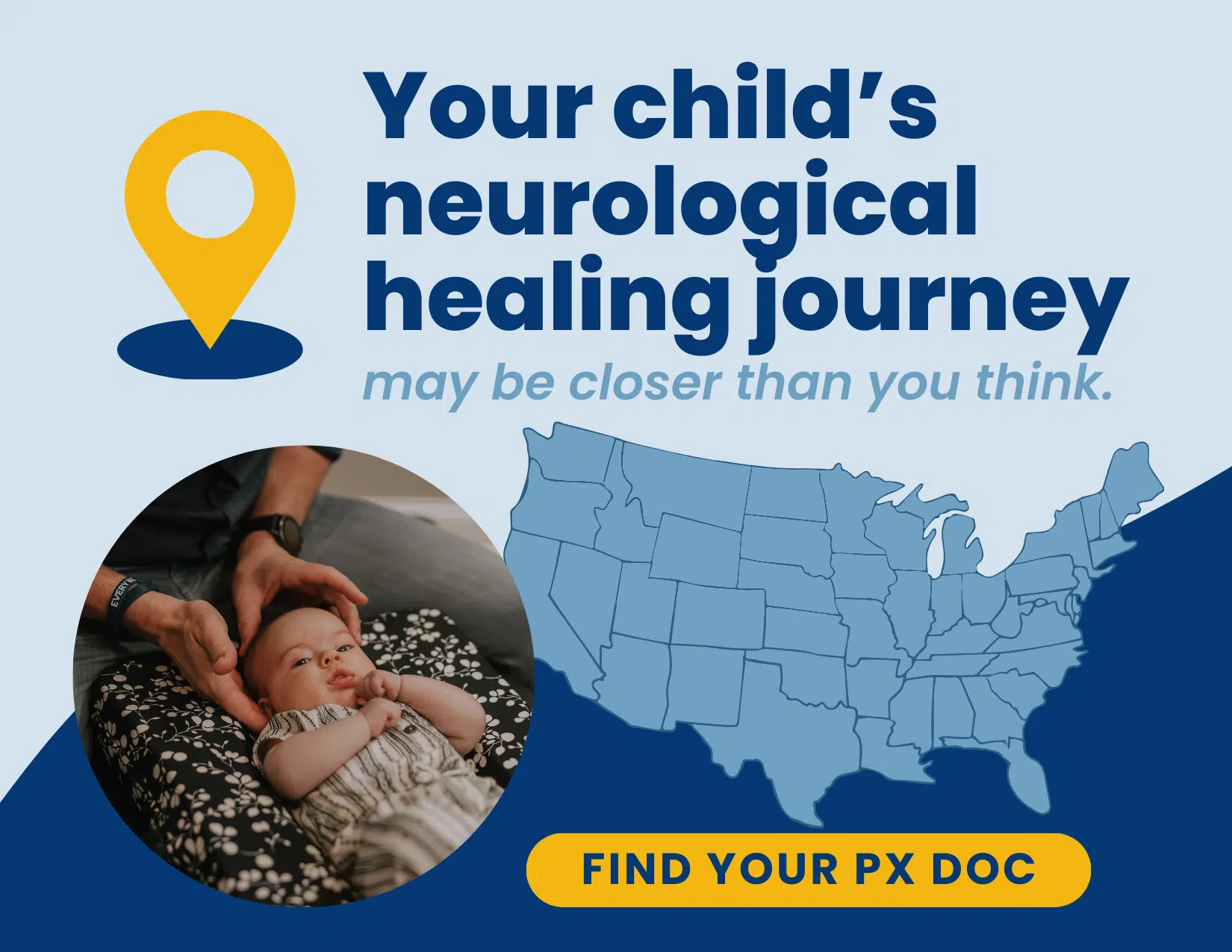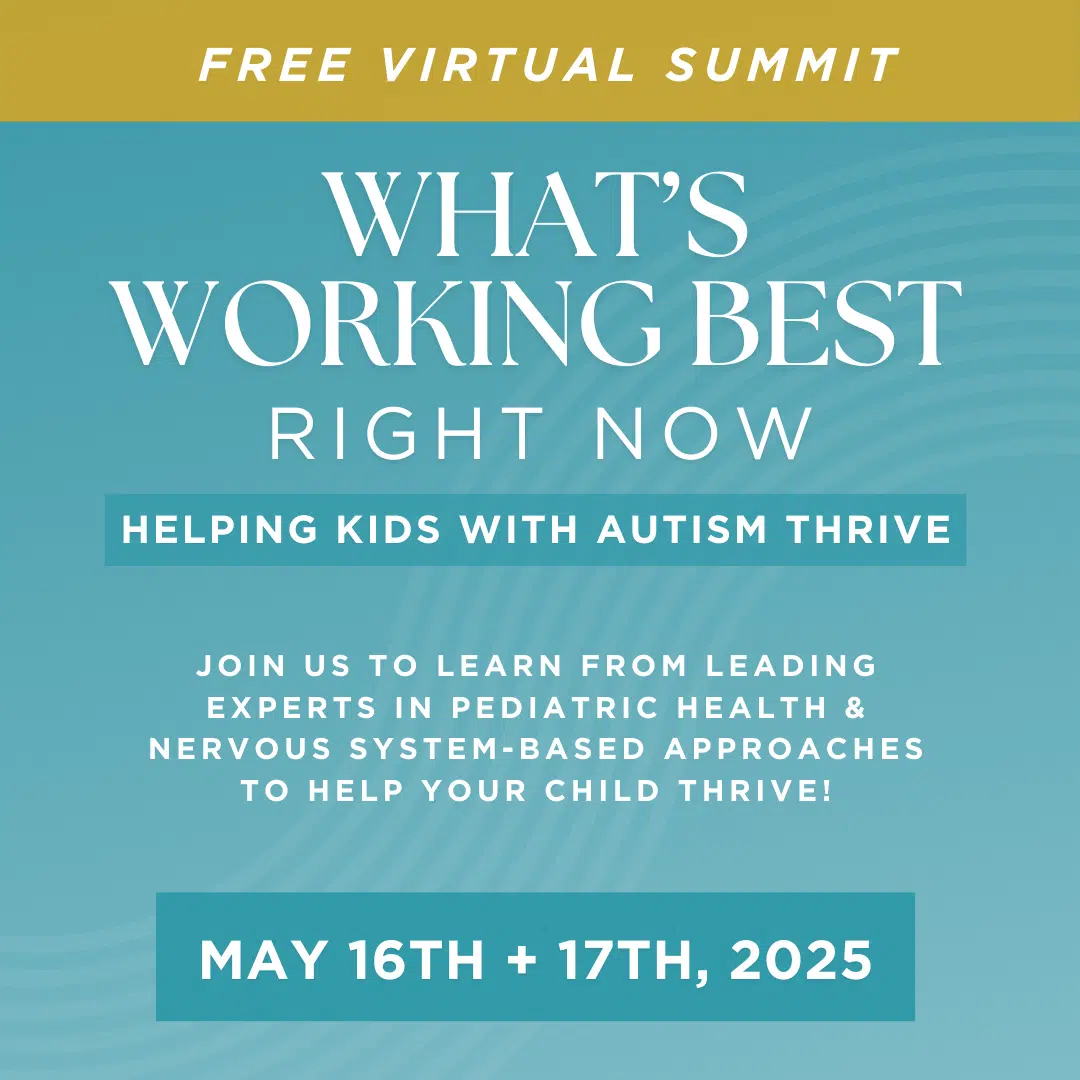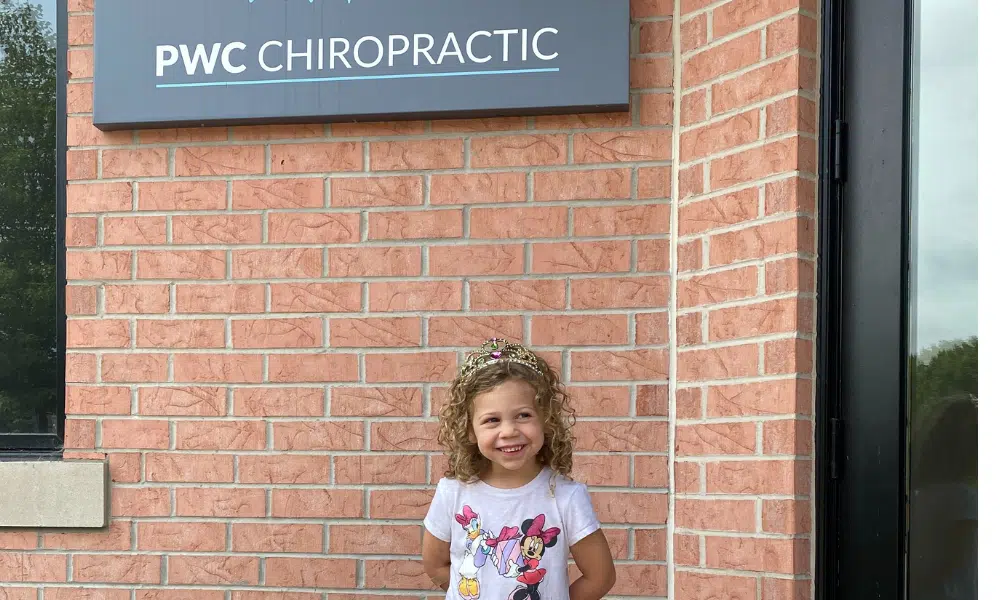If you’re a parent of a child dealing with behavior problems, you know these situations all too well. The tantrums, outbursts, and constant battles can feel overwhelming and exhausting. You’re not alone in this struggle—behavioral challenges are incredibly common, with one in five children having a diagnosed mental, emotional, or behavioral issue, according to Johns Hopkins.
But here’s the good news: there is hope and drug-free help available!
Instead of simply masking the issues with medications or relying solely on surface-level interventions, there are approaches that dig deeper. PX Docs recognize that an overstressed, imbalanced nervous system is often at the core of a child’s struggles.
That was exactly what Ian’s parents were looking for when they sought out our help for this constant outburst, aggression, and emotional dysregulation. As Ian started to struggle more and more in school and with his siblings, his teachers and doctors started to put pressure on his parents to medicate him for ADHD.
Knowing the detrimental side effects of those medications, and knowing that Ian had so much compassion, joy, and creativity that they didn’t want to suppress, they instead first turned to Neurologically-Focused Chiropractic Care and a drug-free approach.
When they started care with Ian, they saw differences and improvements right away. He was more relaxed, focused, and happier and started to finally enjoy school, control his emotions, and not get frustrated so quickly.
As you continue reading, we’ll help you understand the neuroscience behind behavior issues and how a nervous system-focused approach can lead to real, lasting progress—all without the need for heavy medications. This article is for you if you’ve been seeking answers and drug-free options for your child’s behavior issues.
Understanding Behavior Issues in Kids
Behavioral issues in children can manifest in many ways, from frequent tantrums and emotional outbursts to defiance, aggression, or difficulty focusing and regulating emotions. While some of these behaviors are normal parts of child development, they may indicate a more significant underlying issue when they become persistent, intense, and disruptive to daily life.
It’s important to recognize that typical behaviors vary depending on a child’s age and developmental stage. For example:
- Toddlers (1-3 years) are known for their emotional volatility and may frequently display tantrums or meltdowns as they navigate their growing independence and limited communication skills.
- Preschoolers (3-5 years) are learning to regulate their emotions and behavior but may still struggle with impulsivity, defiance, and occasional aggression as they develop social skills and self-control.
- School-age children (6-12 years) are expected to have more emotional and behavioral regulation but may still exhibit periodic outbursts, defiance, or difficulties with focus and following directions.
However, when these behaviors become consistently disruptive, cause significant distress for the child or family, and interfere with daily functioning, it may signal a more pervasive behavior issue that requires attention and support.
At PX Docs, we recognize that many behavioral challenges stem from an underlying imbalance in the nervous system. When a child’s nervous system is stuck in a state of high stress and dysregulation, it can manifest outwardly as difficult behaviors.
By understanding the root neurological causes of these issues, we can take a more targeted, effective approach to helping children and families find relief and restore balance.

The Neuroscience Behind Behavior Issues
To fully understand the root causes of behavior issues in children, it’s essential to explore the various perspectives within the scientific community. Traditionally, the medical field has focused on the role of genetics and neurotransmitter imbalances in behavioral challenges. While these factors undoubtedly play a part, relying solely on these explanations provides an incomplete picture.
We like to explain to parents that while the neurotransmitter imbalance theory that is still predominant in traditional medicine today gets close to really explaining the root cause, there is definitely something deeper going on and neurotransmitters don’t tell the whole story. Simply put, those chemicals “work for” the nervous system. It literally says it right there in their name – they transmit messages for the “neuro” system. Therefore the problem isn’t with the chemicals, it stems from the nervous system itself being imbalanced and dysregulated.
Look for practitioners who take a neuro-focused approach instead of a chemical-focused approach, recognizing that the nervous system is central in regulating a child’s behavior and emotional responses. When the nervous system is stuck in a state of dysfunction, known as subluxation, it can lead to behavioral and developmental challenges.
Subluxation occurs when there is a misalignment or imbalance in the spinal column, leading to dysfunction and interference in the nervous system. This can cause the sympathetic nervous system (the “gas pedal”) to become dominant, leaving a child in a perpetual fight-or-flight state and therefore more prone to outburst, meltdowns, tantrums, and so forth.
At the same time, the parasympathetic nervous system (the “brake pedal”), which is responsible for rest, digestion, and emotional regulation, becomes suppressed. This imbalance is known as dysautonomia.
Putting it altogether, if a child has an overactive sympathetic fight or flight “gas pedal” and an underactive or suppressed parasympathetic “brake” pedal, they’re going to be more wound up and stressed out even at rest. That means when it comes time to make transitions, listen and follow directions, play nicely with other children, and so forth, they often become easily overwhelmed and act out with tantrums and meltdowns.
Many factors can contribute to subluxation and dysautonomia in children, creating a “Perfect Storm” of neurological dysfunction. These early life triggers may include:
- Prenatal stress and maternal health issues
- Birth interventions and trauma (e.g., c-section, forceps, vacuum extraction)
- Childhood falls, injuries, and physical stressors
- Environmental toxins and nutrient deficiencies
- Emotional stress and adverse experiences
When left unaddressed, subluxation and dysautonomia can lead to a state of dysregulation, where the body’s physiological responses become inappropriate and exaggerated. This can manifest as chronic stress, emotional reactivity, and behavioral challenges.
PX Docs address behavior issues at their root cause by understanding neurological factors. We’ll explore how early life stressors contribute to these challenges and how Neurologically-Focused Chiropractic Care can restore balance and function to the nervous system.
How Early Life Stressors Contribute to Behavior Issues
The foundation for a child’s neurological health and development is established before birth, with early experiences and exposures shaping their future behavioral patterns. Prenatal stress and maternal distress, such as high levels of anxiety, depression, or exposure to traumatic events, can significantly impact the developing nervous system. Research indicates that maternal stress hormones can cross the placenta, potentially altering the child’s brain architecture and stress response systems.
Birth itself is another critical period during which the delicate nervous system can be vulnerable to injury and dysregulation. Birth interventions and trauma, such as forceps or vacuum extraction, prolonged labor, or emergency c-sections, can exert physical strain and compression on the infant’s spine and cranium. This can lead to subluxations, impairing nervous system function from the beginning of life.
As a child grows and develops, missing key milestones or experiencing delays in motor, language, or social skills can serve as early indicators of underlying neurological imbalances. These delays may stem from altered brain development and function caused by early life stressors.
A Child’s Brain Development
Specific brain regions and their associated functions can be particularly vulnerable to the impact of early adversity:
- The prefrontal cortex, responsible for executive functions like decision-making, impulse control, and social behavior, undergoes critical development throughout childhood and adolescence. Early stressors can hinder its development, leading to difficulties with self-regulation and social interactions.
- The amygdala, involved in emotional processing and fear responses, may become hyperactive due to early life stress, resulting in heightened reactivity, anxiety, and challenges with emotional regulation.
- The hippocampus plays a key role in memory, learning, and regulating the stress response. Chronic stress can impair its development and function, affecting a child’s ability to manage stress and regulate emotions effectively.
- The cerebellum, traditionally associated with motor coordination, also contributes to emotional processing, behavioral regulation, and cognitive functions. Altered cerebellar development due to early stressors may contribute to some children’s emotional and behavioral challenges.
By recognizing the profound impact of early life experiences on a child’s developing nervous system, we can better understand the root causes of many behavioral issues.
This knowledge empowers us to take a proactive, comprehensive approach to support children’s neurological health and resilience from the earliest stages of life.
The PX Docs Approach: Neurologically-Focused Chiropractic Care
Our Neurologically-Focused Chiropractic Care aims to address behavior issues in children by focusing on the health and function of the nervous system, rather than simply masking symptoms with medications.
This drug-free, neurological approach has two primary goals:
- Releasing the stuck sympathetic response (the “gas pedal”) that keeps a child in a state of chronic stress and hyperarousal.
- Activating the vagus nerve and parasympathetic system (the “brake pedal”) to promote relaxation, emotional regulation, and overall balance.
By addressing these neurological imbalances, chiropractic care helps to create a foundation for improved behavior, emotional regulation, and overall well-being. Healing is a process that requires time and consistency.
Regular chiropractic adjustments, with a supportive home environment and other necessary interventions, can help children progress toward better behavior and emotional health.
Answers and Relief Are Closer Than You Think
Understanding and addressing behavior issues in children is complex. These challenges are influenced by the developing nervous system, early life experiences, and environmental factors.
By learning about the neuroscience behind these challenges, as well as the impact of subluxation and dysautonomia, we can better support children’s behavioral and emotional well-being.
The PX Docs’ Neurologically-Focused Chiropractic Care offers a powerful, drug-free pathway to address the underlying causes of behavior issues and promote optimal nervous system function. Find a PX Doc near you and schedule a visit for your child.
If you’re a parent searching for answers and support for your child’s behavioral challenges, know that you’re not alone and that there is hope. We encourage you to explore the resources available through PX Docs, connect with a local PX Docs provider, and take the first steps towards a brighter, more balanced future for your child and family.






